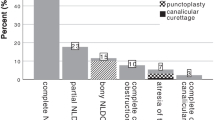Abstract
Dacryocystorhinostomy (DCR) is performed in patients with saccal or postsaccal lacrimal duct obstruction. Focusing on the endonasal approach, we compared success rates, clinical outcome, complications and patient satisfaction of endoscopic vs. non-endoscopic techniques in endonasal DCR. We analyzed the results of 173 patients who underwent an endonasal DCR either utilizing a non-endoscopic (Group I) or an endoscopic technique (Group II) between 2006 and 2011. Irrigation tests followed the first day and at least 3 months after surgery. Postoperative patients’ satisfaction and the occurrence of symptoms were documented and evaluated in a follow-up questionnaire. The minor complication rates of both endonasal DCR techniques were similarly low (10 %) without severe adverse events. The use of the endoscope prolonged the operating time significantly (28 ± 9 min Group I vs. 34 ± 14 min Group II, p = 0.003). The success rate was 90.2 % in Group II compared to only 57.9 % in Group I (p < 0.000). Further, we determined the absence of reflux during the irrigation test 1 day after surgery as a significant predictor for the later outcome (R = 1.598, p = 0.005). The follow-up questionnaire revealed a significant improvement in subjectively perceived symptoms by the surgical intervention for both endonasal techniques (p < 0.000). The endoscopically assisted DCR is a safe and successful endonasal technique for patients with saccal or postsaccal lacrimal duct obstructions. The use of the endoscope led to significant higher success rates compared to non-endoscopic techniques in our collective.




Similar content being viewed by others
References
Toti A (1904) Nuovo metodo conservatore dicura radicale delle suppurazioni croniche del sacco lacrimale (dacriocistorinostomia). Clin Mod Firenze 10:385
Dupuy-Dutemps L, Bourguet M (1921) Procédé plastique de dacryocysto-rhinostomie et ses résultats. Ann Ocul 158:241–261
Karim R, Ghabrial R, Lynch T, Tang B (2011) A comparison of external and endoscopic endonasal dacryocystorhinostomy for acquired nasolacrimal duct obstruction. Clin Ophthalmol 5:979–989
Leong SC, Macewen CJ, White PS (2010) A systematic review of outcomes after dacryocystorhinostomy in adults. Am J Rhinol Allergy 24(1):81–90
Caldwell GW (1893) Two new operations for obstruction of the nasal duct, with preservation of the canaliculi. Am J Ophtamol 10:189–192
West JM (1914) A window resection of the nasal duct in stenosis. Trans Am Ophtalmol Soc 12:654–658
Mirza S, Al-Barmani A, Douglas SA, Bearn MA, Robson AK (2002) A retrospective comparison of endonasal KTP laser dacryocystorhinostomy versus external dacryocystorhinostomy. Clin Otolaryngol 27(5):347–351
Ben Simon GJ, Joseph J, Lee S, Schwarcz RM, Mc Cann JD, Goldberg (2005) External versus endoscopic dacryocystorhinostomy for acquired nasolacrimal duct obstruction in a tertiary referral center. Ophthalmology 112(8):1463–1468
Cho WK, Paik JS, Yang SW (2013) Surgical success rate comparison in functional nasolacrimal duct obstruction: simple lacrimal stent versus endoscopic versus external dacryocystorhinostomy. Eur Arch Otorhinolaryngol 270:535–540
Muellner K, Bodner E, Mannor GE, Wolf G, Hofmann T, Luxenberger W (2000) Endolacrimal laser assisted lacrimal surgery. Br J Ophthalmol 84(1):16–18
Neyt P, Delsupehe L (2011) Powered endonasal dacryocystorhinostomy: technique and results of a series of patients. Bull Soc Belge Ophtalmol 317:33–38
Massegur H, Trias E, Ademà JM (2004) Endoscopic dacryocystorhinostomy: modified technique. Otolaryngol Head Neck Surg 130(1):39–46
Patel BCK (2009) Management of acquired nasolacrimal duct obstruction: external and endonasal dacryocystorhinostomy. Is there a third way? Br J Ophthalmol 93(11):1416–1419
Zenk J, Karatzanis AD, Psychogios G, Franzke K, Koch M, Hornung J, Velegrakis GO, Iro H (2009) Long-term results of endonasal dacryocystorhinostomy. Eur Arch Otorhinolaryngol 266:1733–1738
Janssen AG, Mansour K, Bos JJ, Castelijuy JA (2001) Diameter of the bony lacrimal canal: normal values and values related to nasolacrimal duct obstruction: assessment with CT. Am J Neuroradiol 22:845–850
Mak ST, Io IY, Wong AC (2013) Prognostic factors for outcome of endoscopic dacryocystorhinostomy in patients with primary acquired nasolacrimal duct obstruction. Graefes Arch Clin Exp Ophthalmol 251(5):1361–1367
Narioka J, Ohashi Y (2008) Transcanalicular-endonasal semiconductor diode laser-assisted revision surgery for failed external dacryocystorhinostomy. Am J Ophtalmol 146(1):60–68
Preechawai P (2012) Results of nonendoscopic endonasal dacryocystorhinostomy. Clin Ophthalmol 6:1297–1301
Al-Qahtani AS (2012) Primary endoscopic dacryocystorhinostomy with or without silicone tubing: a prospective randomized study. Am J Rhinol Allergy 26(4):332–334
Mathew MR, McGuiness R, Webb LA, Murray SB, Esakowitz L (2004) Patient satisfaction in our initial experience with endonasal endoscopic non-laser dacryocystorhinostomy. Orbit 23(2):77–85
Jones DT, Fajardo NF, Petersen RA, VanderVeen DK (2007) Pediatric endoscopic dacryocystorhinostomy failure: who and why? Laryngoscope 117(2):323–327
Conflict of interest
All authors declare no conflicts of interest.
Author information
Authors and Affiliations
Corresponding author
Additional information
I.-S. Horn and M. Tittmann contributed equally to the writing of the manuscript.
Rights and permissions
About this article
Cite this article
Horn, IS., Tittmann, M., Fischer, M. et al. Endonasal nasolacrimal duct surgery: a comparative study of two techniques. Eur Arch Otorhinolaryngol 271, 1923–1931 (2014). https://doi.org/10.1007/s00405-013-2774-8
Received:
Accepted:
Published:
Issue Date:
DOI: https://doi.org/10.1007/s00405-013-2774-8




